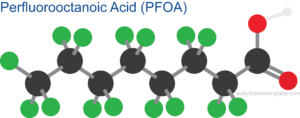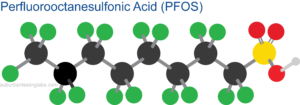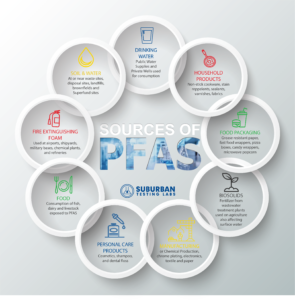Sources of Exposure to PFAs

Research has shown that PFOA and PFOS, two chemicals in the PFAS family, cause harm to humans, other mammals, and sea life. PFAS chemicals have a long history of use in consumer products, industrial development, and manufacturing since the 1940s. Studies have shown evidence of their harm to reproductive, developmental, and immunological systems with additional side effects. Understandably, environmental testing requirements for PFAS are becoming more common in the United States for state and federal jurisdictions to safeguard people’s health and protect the environment.
PFAS: What Are They?
PFAS are a growing collection of manufactured chemicals that are frequently used to create a variety of everyday products. They prevent leftover food from getting stuck to dishes and kitchen tools, they ensure clothing and carpeting are more stain resistant, and they help develop firefighting foam that is especially effective. PFAS are popular in industries like aerospace, military defense, construction, electronic product development, and more.
PFAS molecules exist as a series of connected carbon and fluorine atoms. Since their carbon-fluorine connection is one of the toughest in the chemical family, these chemicals resist decay or deterioration in their environments. Interestingly, scientists are currently not able to create a reliable estimate of an environmental half-life for PFAS, meaning the amount of time required for 50% of the chemical to disappear.
Studies on two types of PFAS is the standard basis for our scientific understanding about this chemical family. Perfluorooctanoic acid (PFOA) and perfluorooctane sulfonate (PFOS) were developed for the longest period, they are the most distributed in the environment, and they’re the best-suited for research.


PFAS: How Are People Exposed?

People are exposed to PFAS through a wide selection of potential sources every day, such as by drinking contaminated water, eating seafood from waterways with PFAS, accidentally breathing dust or soil, using non-stick cookware, using stain-repellant carpets, wearing water-resistant clothing, and more. FDA research has discovered that PFAS can collect in the liver, fat, and even the plasma of rats, and persist for 50 percent of their lifespan.
Contamination from PFAS has been connected to numerous health challenges in people, such as kidney cancer, testicular cancer, thyroid disease, liver damage, pregnancy-induced preeclampsia, and immune dysfunctions. More currently, there is persuasive research pressuring lawmakers to prioritize and fast-track PFAS regulations to improve awareness of and prevent harmful exposure.
Recent research by the Centers for Disease Control and Prevention’s National Health and Nutrition Examination Survey (NHANES) discovered PFAS in the blood of 97% of U.S. citizens. Another and even more recent NHANES study concluded that there was a decrease in blood levels of PFOS and PFOA after their removal from consumer products in the early 2000s. Despite this success, a substantial number of new PFAS chemicals seem to be increasing, and exposure levels and severities are difficult to assess.
New research has provided evidence that exposure to PFOA and PFOS from recent consumer products is typically low, and that exposure is much more of a risk in contaminated drinking water. Some additional products that may contain PFAS chemicals include:
- Cleaning products
- Cardboard boxes
- Anti-stick cookware
- Stain-resistant conditioning for carpets and upholstery
- Water-repellent clothing
- Hygiene products and cosmetics
- Food containers and wrappers, microwave popcorn bags
- Paints, varnishes, and chemical sealants
PFAS: Reduce Your Exposure With A Few Tips
While it’s almost impossible to completely prevent exposure, if your drinking water includes increased levels of PFAS chemicals as defined by the EPA or your state government, you should use a different water source for drinking, making meals, brushing your teeth, and any other activity when you may swallow water. If your home gets its water from a well service, you should conduct regular well testing to ensure the overall quality of the water and whether it contains PFAS.
Avoid eating contaminated fish. You can check which waterways are riskier by contacting your state fish advisory programs using EPA’s list of state, territory, and tribal fish advisory contacts.
If you have any questions about the sources of PFAS chemicals and how to reduce the potential for exposure in your daily life, feel free to contact us online or by phone!
Suburban Testing Labs is a NELAP Accredited environmental testing lab that operates in a 25,000 square foot, state-of-the-art facility in Reading, PA. Founded in 1963, we are a family owned an operated, independent lab that understand the needs of our clients.
We offer high quality analytical data at fast turnaround times and first class customer service.
Stop settling for bad service from your lab. Get to know who we are.
Partner with the leader in Environmental Lab Testing.
Interested in getting a quotation or proposal? Email our team of experts for information on how we can be your partner for success. Click below or email sales@suburbantestinglabs.com.
Already a client?
We can help you with all of your analytical testing needs today. If you’re already a client, email or call (610.375.TEST) our team of project managers to get your new project started now.

